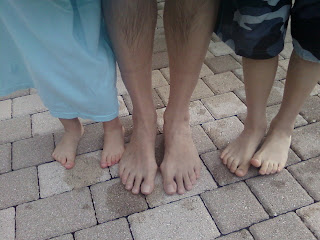Dealing With Bunions
Overview
 A bunion is a bony protrusion on the side of the big toe or in some less common cases on the outside of the small toe. The protrusion at the joint of the base of the toe can become irritated, swollen and painful. As the protrusion becomes larger the toe bends toward the second toe causing further sources of irritation. There appears to be multiple causes of a bunion. Genetically the foot may be shaped such that normal activity puts excessive pressure on the big toe eventually causing a bunion. Some suggest footwear that does not fit properly may also put excessive pressure and cause a bunion. The protrusion may be excessive bone structure or a fluid sac called the bursa that becomes inflamed. In any case the deformity of the toe makes it difficult to find proper fitting footwear, is not a pleasant sight, and can be very painful.
A bunion is a bony protrusion on the side of the big toe or in some less common cases on the outside of the small toe. The protrusion at the joint of the base of the toe can become irritated, swollen and painful. As the protrusion becomes larger the toe bends toward the second toe causing further sources of irritation. There appears to be multiple causes of a bunion. Genetically the foot may be shaped such that normal activity puts excessive pressure on the big toe eventually causing a bunion. Some suggest footwear that does not fit properly may also put excessive pressure and cause a bunion. The protrusion may be excessive bone structure or a fluid sac called the bursa that becomes inflamed. In any case the deformity of the toe makes it difficult to find proper fitting footwear, is not a pleasant sight, and can be very painful.
Causes
Bunions are most often caused by an inherited faulty mechanical structure of the foot. It is not the bunion itself that is inherited, but certain foot types that make a person prone to developing a bunion. Although wearing shoes that crowd the toes won?t actually cause bunions, it sometimes makes the deformity get progressively worse. Symptoms may therefore appear sooner.
Symptoms
Since the pain from a bunion is always aggravated by shoe wear, the symptoms will often depend on the type and size of shoes worn. The perception of pain or discomfort that people experience is quite varied. There are some individuals who have small bunions that are very uncomfortable. This limits their ability to wear shoes comfortably. On the other hand, some individuals may have quite significant deformities that are annoying but do not limit their activities in anyway.
Diagnosis
X-rays are the best way to determine the amount of deformity of the MTP joint. Blood work may be required to rule out other diseases that may be associated with bunions such as rheumatoid arthritis. Other tests such as bone scans or MRI's are not usually required.
Non Surgical Treatment
The most common cause of a bunion is over pronation, this is when your foot rotates in too much as you walk. You really need to treat the underlying cause of the bunion as soon as possible to prevent any further damage. Wear wide fitting shoes, preferably with a leather upper which will allow a stretch. Avoid high heeled shoes. Bunion exercises will help to keep the joint flexible. Bunion surgery may be required in some patients, however this should only be considered when all non-surgical treatment options have been used. Bunion surgery has improved dramatically over the last 20 years but it still cannot guarantee a total recovery and often post operative complications such as calluses and corns can occur depending on the procedure used. If your bunion becomes painful, red and swollen, try using ice on the joint and elevate the foot on a stool. Bunion Night Splints can reduce the size of the bunion. This will straighten the bunion while you sleep. A Bunion Shield can reduce the pain over the bunion. Performing stretches on your toes and feet while you go about your daily routine. This increases circulation, red blood cell activity, and bone realignment. The easiest way to do this is by using a soft, flexible, medical grade gel Toe stretcher which is gentle between the toes and helps to straighten your toes. 
Surgical Treatment
If the conservative options fail, your doctor will determine the best surgical procedure based on the severity of your condition. The most common surgical procedure is a bunionectomy, which includes removing swollen tissue from around your big toe joint. Removing part of the bone to straighten your big toe. Realigning the metatarsal bone to reduce angular deformity. Joining the bones in a corrected position to permanently correct the deformity. Most people can get up and walk around the day after bunion surgery, but full recovery can occasionally take up to eight weeks or more. Doctors stress the importance of wearing proper shoes, especially after treatment, to prevent recurrence. If you are at higher risk or prone to bunions, you may not be able to avoid recurrence.
Prevention
To help prevent bunions be sure your shoes don't cramp or irritate your toes. Choose shoes with a wide toe box - there should be space between the tip of your longest toe and the end of the shoe. Your shoes should conform to the shape of your feet without squeezing or pressing any part of your foot. Avoid pointy-toed shoes.